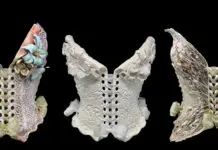Award-winning editorial cartoonist Bruce Plante makes readers of Tulsa World think and laugh every weekday. He has more than 30 years of experience making thoughtful points about important political and social issues – with just one panel and a couple of word balloons. He is syndicated, his work appearing in newspapers and magazines from the New York Times to Newsweek.
Oklahoma Magazine: You’re coming up on three decades of professional cartooning. But when did you actually begin cartooning?
BP: Second grade. I drew a caricature of my teacher. She wasn’t supposed to see it, but she did. She grabbed the cartoon and dragged me into the hallway and started spanking me. She told me that cartooning was never going to get me anywhere. She did that spanking based on how many syllables the cartoon’s sentence had. It just made me try harder.
OM: During your career, which president has provided you with the most material?
BP: Reagan, and maybe Clinton. They’re real close. But probably Reagan.
OM: Which president has provided you with the best material?
BP: (laughs) I guess Clinton. Let’s just say I was for Clinton, voted for Clinton and, coming from Arkansas originally, I was really rooting for him. Then he pissed me off. I kind of vented my spleen, which always makes for better editorial cartoons.
OM: There are many paths that a talented illustrator can take. How did you arrive at political commentary and editorial work?
BP: That started in college. I knew I wanted to be a cartoonist. I grew up drawing characters from Marvel comics and MAD Magazine, that sort of thing. I was a real Spider-Man nut. Loved Thor. I got really bored drawing the stuff we had to draw for fine arts majors at the university. So, I started drawing caricatures at Six Flags Over Texas, just to get my foot in some kind of cartooning. When I got back to the university, I started drawing caricatures at fraternity parties and that sort of thing.Somebody dared me to draw the student government president. I drew it. I gave it to my friend. I didn’t know he worked for the student newspaper, and he gave it to the editor, who printed it. It got a lot of reaction. It was kind of cool. Then the student newspaper editor called me up and asked if I wanted to do this on a regular basis for pay. So I thought, ‘Well, this must be it.’ Then I visited my mentor, George Fisher, and asked him what an editorial cartoonist is supposed to do.
OM: Fisher was a wonderfully talented editorial cartoonist. What sort of stuff did you learn from him?
BP: He’s one of my heroes. He actually changed the community that he worked in with his cartoons. Ever since I worked with him, that’s what my goal has been – make Oklahoma, the state that I’m in, a much better state.
OM: Your topics can be very complex. You only have one panel and one, maybe two word balloons to get your message across.
BP: Twain had a quote: “I have made this letter longer than usual, only because I have not had time to make it shorter.”
It’s harder to write a sentence than it is to write a short story. One thing that’s interesting about this is that (editorial cartoonists) have to rely on what people know. Often, most people aren’t really that familiar with the issue.
Sometimes details I pick out and use aren’t known by most of the readers. When you see a wordy editorial cartoon, that’s the reason we do it – we can’t always count on people being aware of an issue. Sometimes, though, it makes us pick the subjects based on what people know – they’re all going on about Donald Trump now. They’re all going to know about Osama being killed.
OM: You’ve been doing this for a long time. You have to do five of these a week. Has the pressure ever gotten to you?
BP: Nope. It’s just one of those things that is part of life. I’m always thinking about a cartoon, hoping that it’d just hit me. I wish it happened like that more often. Earlier in my career it did. But I’m so used to deadlines now that it’s just not that big a deal. But sometimes that’s why you see a bad cartoon out there.

























